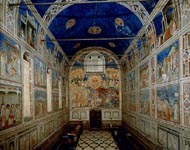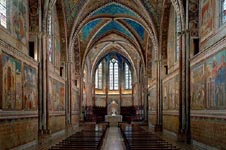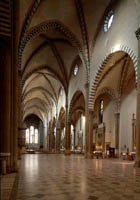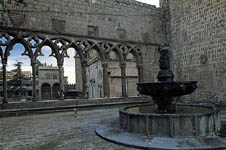Gothic art
Gothic art appeared in the middle of the XII century and continued till the XIV century. It was born in Il-de-France and spread to the rest of Europe, including Italy.
In Italy the XIV century was one of the most amazing periods for artistic development. Strong political and cultural changes were taking place in the country and in this period the Guilds of Arts and Trades first appeared, the middle class became a socially active class and the first municipalities, which would then became Seignories, were born.
The word ‘gothic’, meaning ‘barbarian’, was used for the art of this period to designate artistic trends from the end of classical art. This negative meaning lasted till the end of the XVIII century.
Gothic painting
 Gothic painting styles, like those of sculpture and architecture, took on different characteristics depending on the region they developed in. Outside Italy paintingwas not as important as sculpture and architecture: the typically Romanesque fresco paintings vanished completely and were replaced by stained glass in the great cathedrals. In Italy stained glass never replaced frescos, mosaics or painted boards. Influence from Europe overlapped with the Byzantine style which had survived in Italy. Three different painting schools started: the school of Siena, with Duccio di Buoninsegna, Simone Martini, Ambrogio Lorenzetti; the school of Florence with Giotto as most important representative, and the school of Rome, whose major representative was Pietro Cavallini.
Gothic painting styles, like those of sculpture and architecture, took on different characteristics depending on the region they developed in. Outside Italy paintingwas not as important as sculpture and architecture: the typically Romanesque fresco paintings vanished completely and were replaced by stained glass in the great cathedrals. In Italy stained glass never replaced frescos, mosaics or painted boards. Influence from Europe overlapped with the Byzantine style which had survived in Italy. Three different painting schools started: the school of Siena, with Duccio di Buoninsegna, Simone Martini, Ambrogio Lorenzetti; the school of Florence with Giotto as most important representative, and the school of Rome, whose major representative was Pietro Cavallini.
There is no doubt that Giotto’s painting influenced all the painters of the time because he created a highly human and natural painting style. The frescos in the basilica of S. Francesco ad Assisi and those he painted in the Scrovegni chapel in Padua are excellent examples of his style.
Gothic sculpture
European gothic art influenced Italy’s art in the middle of the XIII century. Many sculptors were deeply impressed by imported works of sculpture and abandoned Romanesque tradition. In northern Italy examples of sculpture inspired by European gothic art are the carvings of the gable of the cuspid portico of the Duomo of Ferrara.
In southern Italy gothic sculpture spread at the end of the XIII century thanks to the Anjevin dynasty. In Tuscany, an artist from Puglia, Nicola Pisano, greatly changed the style of Italian sculpture and his work was continued by his followers, including his son Giovanni and Arnolfo di Cambio.
From the end of the XIII century sculpting was closely connected to painting and especially architecture, as shown by the tabernacles built by Arnolfo di Cambio in Rome or by the steeple started by Giotto in Florence. The same applies to ivory carving and jewellery: an example is the Corporal’s reliquary, made by Ugolino di Vieri in the duomo of Orvieto.
Gothic architecture

Italianarchitecture was only slightly influenced by gothic Architecture from the other side of the Alps and during the whole XIII century the traditional style of Romanesque architecture did not change.
The Cistercian monks were the first to introduce the French gothic style into Italy, by adding and overlapping with Romanesque architecture typical gothic elements such as gothic or ogival arches.
The vertical trend of architecture from north of the Alps was softened by the thickness of structures which had no pinnacles, flying buttresses or spires. In general the Italian style was more sober than the other European styles.
Church of San Francesco d'Assisi
The first example of gothic architecture in Italy is the Upper Church of San Francesco d'Assisi. Building started around 1228 and the

church was consecrated in 1253.
The basilica in Assisi is made up of two overlapping churches. The architecture of the Lower Church is typically Romanesque (thick walls, very thick pillars, low vaults with ribs). The Upper Basilica stretches towards the sky and is full of light and its style is therefore reminiscent of French gothic architecture. Inside, the immense stained glass windows, typical of French cathedrals, are replaced by frescos by famous painters such as Giotto.
Church of Santa Maria Novella
The church of Santa Maria Novella in Floren
ce was started in 1278. Ogival arches and slender frame work are held up by polystylar pillars which make this a mainly gothic design whereas the facade decorated
with polychromatic marble marquetry is reminiscent of Romanesque style.
Public buildings
In this period non-religious architecture became important once again as cities grew larger and strengthened theirwalls. Battlement towers were built. In northern Italy a special type of building developed, known as ‘broletto’, a town hall made of bricks, with large halls for meetings. Typical

examples of this type of building are the ‘broletti’ of Como, Milan and Lodi.
There is a larger variety of public buildings in central Italy: an example is the People's Hall of Orvieto, which is actually a modified version of a ‘broletto’. Palazzo Tolomei, in Siena, is a typical example of the style used for public buildings in central Italy: square layout, twoseries of mullioned windows, a central door flanked by two smaller ones.
An exceptional case is the Pope's Hall in Viterbo where civil and military architecture merge. From the main hall there is access to another hall, where light enters through mullioned windows. Next to this is a balcony, once surrounded on all sides by entwined arches resting on small pillars.
In southern Italy civil architecture was replaced by military architecture.
 Gothic painting styles, like those of sculpture and architecture, took on different characteristics depending on the region they developed in. Outside Italy paintingwas not as important as sculpture and architecture: the typically Romanesque fresco paintings vanished completely and were replaced by stained glass in the great cathedrals. In Italy stained glass never replaced frescos, mosaics or painted boards. Influence from Europe overlapped with the Byzantine style which had survived in Italy. Three different painting schools started: the school of Siena, with Duccio di Buoninsegna, Simone Martini, Ambrogio Lorenzetti; the school of Florence with Giotto as most important representative, and the school of Rome, whose major representative was Pietro Cavallini.
Gothic painting styles, like those of sculpture and architecture, took on different characteristics depending on the region they developed in. Outside Italy paintingwas not as important as sculpture and architecture: the typically Romanesque fresco paintings vanished completely and were replaced by stained glass in the great cathedrals. In Italy stained glass never replaced frescos, mosaics or painted boards. Influence from Europe overlapped with the Byzantine style which had survived in Italy. Three different painting schools started: the school of Siena, with Duccio di Buoninsegna, Simone Martini, Ambrogio Lorenzetti; the school of Florence with Giotto as most important representative, and the school of Rome, whose major representative was Pietro Cavallini. Italianarchitecture was only slightly influenced by gothic Architecture from the other side of the Alps and during the whole XIII century the traditional style of Romanesque architecture did not change.
Italianarchitecture was only slightly influenced by gothic Architecture from the other side of the Alps and during the whole XIII century the traditional style of Romanesque architecture did not change.  church was consecrated in 1253.
church was consecrated in 1253. examples of this type of building are the ‘broletti’ of Como, Milan and Lodi.
examples of this type of building are the ‘broletti’ of Como, Milan and Lodi.